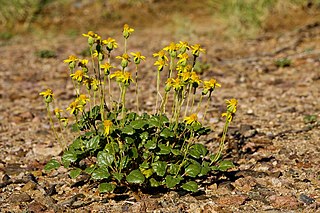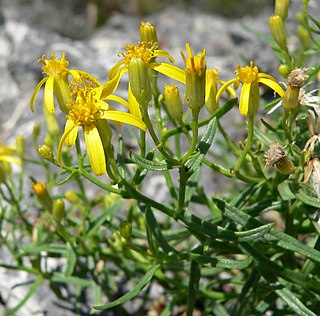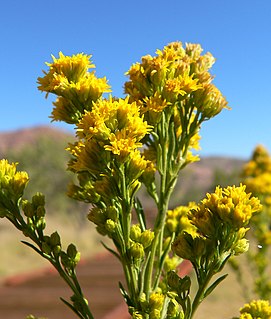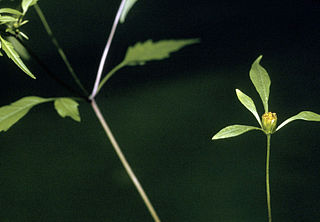
Agoseris aurantiaca is a species of plant in the sunflower family, commonly called orange agoseris or mountain dandelion. It is widespread and common in western North America from Alaska and the Northwest Territories in Canada southward to California, Arizona, and New Mexico, and eastward as far as the Rocky Mountains and the Black Hills. There are also isolated populations in the Chic-Choc Mountains on the Gaspe Peninsula and in the Otish Mountains of central Quebec.

Solidago nemoralis is a species of flowering plant in the aster family, Asteraceae. It is native to North America, where it is widely found in Canada and the United States. Its common names include gray goldenrod, gray-stem goldenrod, old-field goldenrod, field goldenrod, prairie goldenrod, dwarf goldenrod, and dyersweed goldenrod.

Bartlettia is a monotypic genus of flowering plants in the aster family, Asteraceae. It contains the single species Bartlettia scaposa, known commonly as the Bartlett daisy. It is native to Mexico and to New Mexico and Texas in the United States.

Senecio spartioides is a species of flowering plant in the aster family known by the common name broom-like ragwort. It is native to the western United States as far east as the Dakotas and Texas, and northern Mexico. It can be found in dry, rocky, often disturbed areas in a number of habitat types. It is a subshrub which can exceed a meter in height, its arching stems growing from a woody-topped taproot. The leaves are linear in shape and up to 10 centimeters long. The leaves usually have smooth, unlobed edges, but slightly lobed leaves are seen at times. The leaves are evenly distributed along the stems, the ones low on the stems withering away early, giving the plant a naked appearance on the lower half while the top is still lush green and blooming. The inflorescences are spreading, flat-topped arrays of many cylindrical flower heads. The heads contain yellow disc florets and generally either 5 or 8 ray florets each about a centimeter long.
Solidago guiradonis is an uncommon species of goldenrod known by the common name Guirado goldenrod. It is native to the Central California Coast Ranges of central California, in southern San Benito and western Fresno Counties.

Solidago spectabilis is a species of goldenrod known by the common names Nevada goldenrod, basin goldenrod, and showy goldenrod. It is native to the western United States in the Great Basin and surrounding areas. It is found in California, Arizona, Nevada, Oregon, and Utah. There are historical records saying it once grew in southwestern Idaho, but is now extirpated there. This variety has also been seen in the western Montana county of Sanders.

Solidago houghtonii is a rare North American species of flowering plant in the aster family known as Houghton's goldenrod. It is native to southern Ontario, Canada and the northern United States. It is threatened by the loss and degradation of its habitat. It is a federally listed threatened species of the United States and it is designated a species of special concern by Canada's Committee on the Status of Endangered Wildlife in Canada.
Solidago verna is a species of flowering plant in the aster family known by the common names springflowering goldenrod and spring goldenrod. It is native to North Carolina and South Carolina in the United States.

Ratibida pinnata is a species of flowering plant in the family Asteraceae known by the common names pinnate prairie coneflower, gray-head coneflower, yellow coneflower, and prairie coneflower. It is native to the central and eastern United States and Ontario in Canada.
Bahia bigelovii, or Bigelow's bahia, is a North American species of flowering plants in the family Asteraceae. It is native to the State of Coahuila in Mexico and to the western (trans-Pecos) part of the US state of Texas.

Bidens bigelovii is a North American species of flowering plant in the family Asteraceae. It is native to the southwestern and south-central United States and to Mexico as far south as Oaxaca.

Bidens discoidea, the small beggarticks, is a North American species of flowering plant in the family Asteraceae. It is widespread across eastern Canada and the eastern and central United States, from Nova Scotia west to Minnesota, south to Florida and Texas.
Bidens lemmonii is a North American species of flowering plant in the family Asteraceae. It is native to the southwestern United States and Mexico.

Bidens mitis, the smallfruit beggarticks, is a North American species of flowering plant in the family Asteraceae. It is native to the eastern, southeastern, and south-central parts of the United States, from eastern Texas to southern New Jersey.
Bidens tenuisecta , the slim lobe beggarticks, is a North American species of flowering plant in the family Asteraceae. It is native to northern Mexico (Chihuahua) and the western United States. There are also reports of populations in the northeastern United States but these are almost assuredly introductions.
Brickellia laciniata, the splitleaf brickellbush, is a North American species of flowering plants in the family Asteraceae. It is native to northeastern and north-central Mexico and the southwestern United States.
Brickellia lemmonii, or Lemmon's brickellbush, is a North American species of flowering plants in the family Asteraceae. It is native to northeastern and north-central Mexico and the southwestern United States.
Brickellia cylindracea, the gravelbar brickellbush, is a North American species of flowering plants in the family Asteraceae. It is found only in central Texas.
Helianthus laciniatus is a North American species of sunflower known by the common name alkali sunflower. It is found in the southwestern United States and north-central Mexico. It is fairly common in the Chihuahuan Desert.

Euthamia leptocephala, the bushy goldentop or Mississippi Valley goldentop, is a North American species of plants in the family Asteraceae. It is native to the south-central United States, in the lower Mississippi Valley and the Coastal Plain of the Gulf of Mexico, from Texas to west-central Georgia and north as far as southern Illinois.











